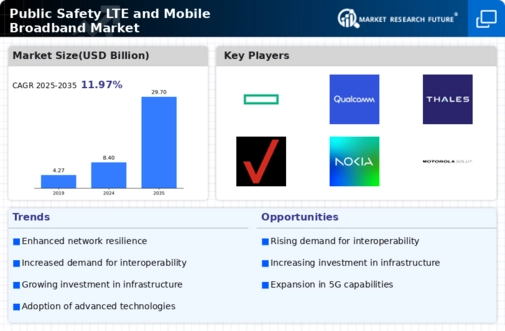Government Initiatives and Funding
Government initiatives play a crucial role in shaping the Public Safety LTE and Mobile Broadband Market. Various governments are increasingly recognizing the importance of advanced communication systems for public safety. For instance, funding programs aimed at enhancing emergency response capabilities have been established, with billions allocated to upgrade communication networks. These initiatives not only provide financial support but also create a regulatory framework that encourages the adoption of LTE technologies. As agencies receive funding, they are more inclined to invest in modern mobile broadband solutions, which can lead to improved operational efficiency and response times. Consequently, the influx of government support is expected to drive market growth significantly.
Rising Incidence of Natural Disasters
The frequency of natural disasters is on the rise, which has a direct impact on the Public Safety LTE and Mobile Broadband Market. As climate change continues to exacerbate weather patterns, emergency services are increasingly called upon to respond to disasters such as floods, wildfires, and hurricanes. This surge in demand for rapid response capabilities necessitates the implementation of advanced communication technologies. Data indicates that regions prone to natural disasters are investing heavily in LTE and mobile broadband systems to ensure effective coordination and communication during crises. The ability to transmit real-time data and maintain connectivity in challenging environments is vital for public safety agencies, thereby propelling market growth in response to these pressing needs.
Growing Focus on Interagency Collaboration
The emphasis on interagency collaboration is reshaping the Public Safety LTE and Mobile Broadband Market. As public safety challenges become more multifaceted, agencies are recognizing the necessity of working together to enhance response efforts. This collaboration often requires integrated communication systems that can facilitate seamless information sharing among different organizations. The market is responding to this need by developing LTE and mobile broadband solutions that support interoperability across various platforms. Data suggests that agencies that utilize collaborative communication tools experience improved outcomes during emergencies. As the trend towards interagency cooperation continues, the demand for advanced communication technologies is expected to rise, further driving market growth.
Increased Demand for Reliable Communication
The Public Safety LTE and Mobile Broadband Market is experiencing heightened demand for reliable communication systems among emergency services. As incidents requiring immediate response become more complex, the need for robust communication networks is paramount. According to recent data, over 70% of public safety agencies report that their existing communication systems are inadequate for current operational demands. This inadequacy drives investment in LTE and mobile broadband solutions, which offer enhanced reliability and coverage. Furthermore, the integration of these technologies allows for seamless communication across various agencies, thereby improving coordination during emergencies. As a result, the market is likely to witness substantial growth as agencies prioritize the establishment of dependable communication infrastructures.
Technological Advancements in Communication
Technological advancements are significantly influencing the Public Safety LTE and Mobile Broadband Market. Innovations such as 5G technology, artificial intelligence, and the Internet of Things are transforming how public safety agencies operate. These advancements enable faster data transmission, improved situational awareness, and enhanced decision-making capabilities. For example, the deployment of 5G networks is expected to provide unprecedented bandwidth and lower latency, which are critical for real-time communication during emergencies. As agencies adopt these cutting-edge technologies, the demand for LTE and mobile broadband solutions is likely to increase, fostering a more efficient and responsive public safety infrastructure. The ongoing evolution of communication technology is thus a key driver of market expansion.


















Leave a Comment